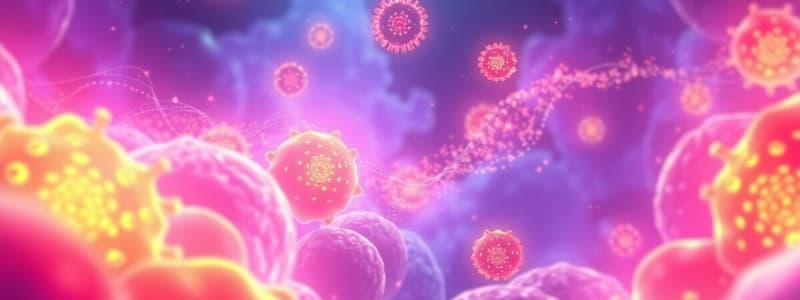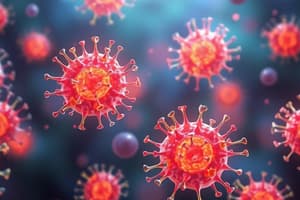Podcast
Questions and Answers
What characterizes innate immunity?
What characterizes innate immunity?
- It requires previous exposure to pathogens.
- It can recognize specific molecular components of pathogens.
- It includes inborn host defenses against a broad range of pathogens. (correct)
- It is solely dependent on adaptive immune responses.
Which statement accurately describes adaptive immunity?
Which statement accurately describes adaptive immunity?
- It functions immediately upon pathogen exposure without training.
- It is directed against individual molecular components known as antigens. (correct)
- It is innate and does not require recognition of specific pathogens.
- It cannot adapt to new pathogens over time.
What role does normal microbiota play in host resistance?
What role does normal microbiota play in host resistance?
- It helps resist pathogens through competitive exclusion. (correct)
- It alters the physical barrier of the skin.
- It provides direct immune responses against viruses.
- It increases susceptibility to infections.
How does the route of infection influence the type of pathogen?
How does the route of infection influence the type of pathogen?
Which of the following is NOT a physical or chemical barrier to infection?
Which of the following is NOT a physical or chemical barrier to infection?
What best describes competitive exclusion in the context of normal microbiota?
What best describes competitive exclusion in the context of normal microbiota?
Which of these statements is true regarding infection sites?
Which of these statements is true regarding infection sites?
What is the primary purpose of mucosal membranes in the immune system?
What is the primary purpose of mucosal membranes in the immune system?
Which of the following statements best describes the relationship between innate and adaptive immunity?
Which of the following statements best describes the relationship between innate and adaptive immunity?
What primary function does stomach acid serve in immune defense?
What primary function does stomach acid serve in immune defense?
What is the main function of the lymphatic system?
What is the main function of the lymphatic system?
Which type of leukocytes are specifically involved in the adaptive immune response?
Which type of leukocytes are specifically involved in the adaptive immune response?
What distinguishes serum from plasma?
What distinguishes serum from plasma?
Which organ is primarily responsible for the maturation of T cells?
Which organ is primarily responsible for the maturation of T cells?
What role do cytokines play in the immune system?
What role do cytokines play in the immune system?
Which cells are known as phagocytes?
Which cells are known as phagocytes?
What is the significance of lymph nodes in the lymphatic system?
What is the significance of lymph nodes in the lymphatic system?
What is the primary function of B cells in the immune response?
What is the primary function of B cells in the immune response?
Where do hematopoietic stem cells primarily develop into different types of blood cells?
Where do hematopoietic stem cells primarily develop into different types of blood cells?
Which component of blood is essential for the clotting process?
Which component of blood is essential for the clotting process?
What function do chemokines specifically serve in the immune response?
What function do chemokines specifically serve in the immune response?
What triggers the recruitment of phagocytes during an immune response?
What triggers the recruitment of phagocytes during an immune response?
Which type of immune cell is primarily responsible for the attraction of neutrophils to an infection site?
Which type of immune cell is primarily responsible for the attraction of neutrophils to an infection site?
Which statement describes a characteristic of cytokines?
Which statement describes a characteristic of cytokines?
What is the primary role of pathogen-associated molecular patterns (PAMPs) in the immune system?
What is the primary role of pathogen-associated molecular patterns (PAMPs) in the immune system?
How do resident leukocytes contribute to an immune response upon tissue damage?
How do resident leukocytes contribute to an immune response upon tissue damage?
Which of the following best describes the process of extravasation in the immune response?
Which of the following best describes the process of extravasation in the immune response?
What is a distinguishing feature of chemokines compared to other cytokines?
What is a distinguishing feature of chemokines compared to other cytokines?
What is the relationship between tissue damage and the immune response?
What is the relationship between tissue damage and the immune response?
Which of the following is NOT a role of cytokines in the immune response?
Which of the following is NOT a role of cytokines in the immune response?
What occurs when a pathogen is recognized by Toll-like receptors (TLRs) on leukocytes?
What occurs when a pathogen is recognized by Toll-like receptors (TLRs) on leukocytes?
Which component is involved in the process of phagocytosis following pathogen recognition?
Which component is involved in the process of phagocytosis following pathogen recognition?
What role does NFκB play in the immune response?
What role does NFκB play in the immune response?
How do phagocytes kill bacteria once they are engulfed?
How do phagocytes kill bacteria once they are engulfed?
What is a common feature of pathogens that can survive inside a phagolysosome?
What is a common feature of pathogens that can survive inside a phagolysosome?
Which structural feature enables leukocytes to recognize pathogen-associated molecular patterns (PAMPs)?
Which structural feature enables leukocytes to recognize pathogen-associated molecular patterns (PAMPs)?
What initiates the phosphorylation cascade in phagocytes upon pathogen recognition?
What initiates the phosphorylation cascade in phagocytes upon pathogen recognition?
Why are pattern recognition receptors (PRRs) crucial for the immune system?
Why are pattern recognition receptors (PRRs) crucial for the immune system?
What is the end result of the signal transduction pathway activated by TLRs?
What is the end result of the signal transduction pathway activated by TLRs?
Which process leads to the creation of a phagolysosome?
Which process leads to the creation of a phagolysosome?
Flashcards
Innate Immunity
Innate Immunity
Inborn, non-specific defense against pathogens.
Adaptive Immunity
Adaptive Immunity
Acquired ability to target specific pathogens.
Normal Microbiota
Normal Microbiota
Beneficial bacteria that protect against pathogens.
Competitive Exclusion
Competitive Exclusion
Signup and view all the flashcards
Pathogen
Pathogen
Signup and view all the flashcards
Infection Site Specificity
Infection Site Specificity
Signup and view all the flashcards
Physical Barriers
Physical Barriers
Signup and view all the flashcards
Mucosal Membranes
Mucosal Membranes
Signup and view all the flashcards
Stomach Acid
Stomach Acid
Signup and view all the flashcards
Skin
Skin
Signup and view all the flashcards
Lymphatic System
Lymphatic System
Signup and view all the flashcards
Lymph Nodes
Lymph Nodes
Signup and view all the flashcards
Leukocytes
Leukocytes
Signup and view all the flashcards
Phagocytes
Phagocytes
Signup and view all the flashcards
Lymphocytes
Lymphocytes
Signup and view all the flashcards
B cells
B cells
Signup and view all the flashcards
T cells
T cells
Signup and view all the flashcards
Plasma
Plasma
Signup and view all the flashcards
Serum
Serum
Signup and view all the flashcards
Bone Marrow
Bone Marrow
Signup and view all the flashcards
What is microbial invasion?
What is microbial invasion?
Signup and view all the flashcards
Tissue damage triggers what?
Tissue damage triggers what?
Signup and view all the flashcards
Cytokines
Cytokines
Signup and view all the flashcards
Chemokines
Chemokines
Signup and view all the flashcards
What do chemokines do?
What do chemokines do?
Signup and view all the flashcards
What happens during extravasation?
What happens during extravasation?
Signup and view all the flashcards
What's the role of PAMPs?
What's the role of PAMPs?
Signup and view all the flashcards
Signal Transduction
Signal Transduction
Signup and view all the flashcards
What does signal transduction allow?
What does signal transduction allow?
Signup and view all the flashcards
PAMPs
PAMPs
Signup and view all the flashcards
TLR
TLR
Signup and view all the flashcards
NFκB
NFκB
Signup and view all the flashcards
Phagosome
Phagosome
Signup and view all the flashcards
Lysosome
Lysosome
Signup and view all the flashcards
Phagolysosome
Phagolysosome
Signup and view all the flashcards
Reactive Oxygen Intermediates (ROIs)
Reactive Oxygen Intermediates (ROIs)
Signup and view all the flashcards
How can pathogens survive phagocytosis?
How can pathogens survive phagocytosis?
Signup and view all the flashcards
Study Notes
Immunity
- Immunity is the ability of an organism to resist infection.
Innate Immunity (Nonspecific Immunity)
- Innate immunity is inborn host defenses against a broad range of pathogens.
- It has a noninducible ability to recognize and destroy individual pathogens or their products.
- It does not require prior exposure to a pathogen or its products.
Adaptive Immunity
- Adaptive immunity is the acquired ability to recognize and destroy a specific pathogen or its products.
- It's dependent on previous exposure to the pathogen or its products (specificity).
- It's directed toward specific molecular components (antigens) of a pathogen.
Innate Immune Cells
- Phagocytes, such as dendritic cells, neutrophils, and macrophages, are primary effector cells.
- They have a rapid response (within hours) to pathogens.
- They lack immune memory.
Adaptive Immune Cells
- Lymphocytes (B and T lymphocytes) are primary effector cells for adaptive immunity.
- Their response is focused, attacking specific pathogens.
- They have pathogen-specific memory.
- These cells require days to respond.
Natural Host Resistance
- Normal microbiota helps the host resist pathogens, particularly on the skin and gut (competitive exclusion).
- The ability of microbes to cause disease varies between species.
Physical and Chemical Barriers to Infection
- Mucosal membranes are coated with mucus.
- Stomach acid (low pH) inhibits bacterial growth.
- Skin is salty and acidic, limiting bacterial growth.
Infection Site and Tissue Specificity
- Different pathogens invade different tissues.
- Routes of infection are crucial. Examples including: tetanus in wounds, Salmonella ingested.
Studying That Suits You
Use AI to generate personalized quizzes and flashcards to suit your learning preferences.
Related Documents
Description
Explore the fundamental concepts of immunity, focusing on the differences between innate and adaptive immunity. This quiz will test your knowledge of the types of immune cells involved and their specific functions in the immune response.




